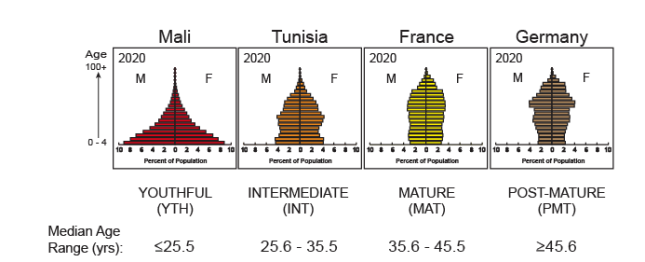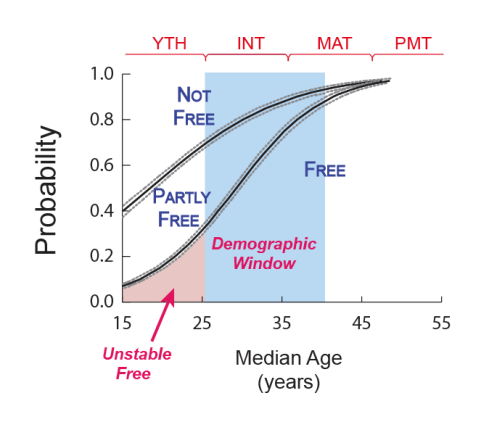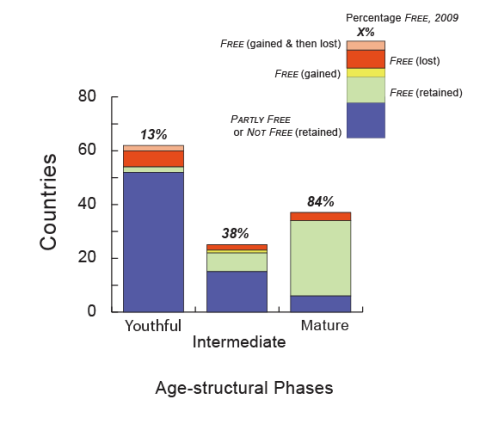-
Predicting the Rise and Demise of Liberal Democracy: How Well Did We Do?
August 17, 2021 By Richard Cincotta
In 2007, at the (U.S.) National Intelligence Council, a colleague and I set out to determine if we could forecast two distinct political phenomena, the rise and the demise of high levels of democracy. To guide our decade-long forecasts, we relied on a simple statistical model and a spreadsheet of demographic projections from the UN’s 2006 World Population Prospects data set. Now that the experimental period (from 2010 to 2020) has ended, we can look back and ask: How well did these forecasts perform?
Overall, surprisingly well; but by no means, flawlessly. In fact, we expected too much political liberalization during a decade when democracy was largely in retreat. Yet, had our age-structural forecasts been taken more seriously when first presented and published (see “Half a Chance”, published by the Wilson Center’s Environmental Change and Security Program), foreign affairs analysts might have been amply forewarned of two of the decade’s most unanticipated political events:
- In North Africa, the rise of Tunisia’s liberal democracy—defined as a democracy with highly developed and legally protected political rights and civil liberties—stood out. In our research, a liberal democracy is indicated by an assessment of Free in Freedom House’s annual survey of political rights and civil liberties. An assessment of Free is the highest scored of Freedom House’s three distinct freedom status categories: Not Free, Partly Free, and Free.
- In West Africa, the loss of nearly all of the region’s liberal democracies—including Mali’s liberal regime, which many Africa analysts believed to be on solid footing—should be noted.
Age-structural Theory, in Brief
The age-structural theory of state behavior (one of political demography’s core theories, detailed in my chapter of the newly-published A Research Agenda for Political Demography) statistically describes the expected social, economic, and political character of countries as they pass through a sequence of four phases that comprise the age-structural transition. This sequence begins among the high-fertility, rapidly growing populations in the youthful phase of the transition, wherein most residents are children, adolescents, and young adults (Fig. 1).
Figure 1. Age-structural phases
Constrained by an age structure that relentlessly augments the demand for jobs, schooling, and other vital services and infrastructure, countries in the transition’s youthful phase typically fail to generate the capacity to meet their citizens’ most basic demands. Youthful countries dominate the World Bank’s low-income and lower-middle income categories (Fig. 2). Armed revolts and separatist insurgencies (intrastate conflicts) are more frequent at this stage, making this initial phase difficult to escape.
By advancing into the next phase, the intermediate phase, countries enter the demographic window—a series of age structures that bulge in the working ages and feature low proportions of both young and elderly dependents. This development-favorable window opens up near a median age of 26 years and ultimately fades as countries near a median age of 40 years, midway through the age-structural transition’s mature phase. Achievable only through fertility decline, entering and moving through the demographic window is associated with the World Bank’s upper-middle income class, as well as with achieving similarly high levels of child survival and educational attainment—all of which help drive and reinforce each other. Most notably, countries in the window face lower risks of intrastate conflict than those that linger longer in the youthful phase.
After the mature phase, age-structural theory identifies the transition’s post-mature phase, where middle-aged and senior residents account for the majority of the population. Countries in this phase are likely to face challenges supporting a growing proportion of elderly with a declining proportion of taxable workers and promoting economic vibrancy as they shift to an older workforce. However, unlike the development challenges that these countries experienced during the transition’s youthful phase, states that enter the post-mature phase have the advantage of high levels of human capital and functioning institutions (currently only Japan, Germany, Italy, and Portugal are in post-mature phase).
Figure 2. Age structures and the World Bank’s per capita income classes, 2018 (excludes countries with less than 5 million residents and Gulf Cooperation Council states)
Since the early 1970s, countries within the demographic window have been the most likely to achieve and maintain Free status. In contrast, countries in the transition’s youthful phase have less frequently attained Free (Fig. 2) and more frequently lost it—in several cases, achieving Free and then dropping to Partly Free or Not Free multiple times. Of course, there are exceptions: Youthful countries with less than 5 million residents—states like Belize, Botswana, Cabo Verde, Namibia, the Solomon Islands, and Timor-Leste—seem, so far, to have encountered few difficulties attaining Free and holding on to that assessment.
Figure 3. Probabilities of Free, Partly Free, and Not Free across the age-structural transition (analysis from 1972 to 2010).
Predicting the Rise of Liberal Democracy
Statistically, this forecast was a tough one to get right. Yet, the logic of selecting countries entering and moving through the demographic window was consistent with age-structural theory. Countries in the window are likely sites for increasing political liberalization because they experience slowing rates of workforce growth, declining rates of children entering schools, and large proportions of small families who can invest in their children, still save, and accrue assets. Employment, income, educational attainment, and health status generally rise, and with more human capital and less pressure on government services, states appear increasingly legitimate to their citizens and less prone to political violence.
For our experiment, we chose two small geographic clusters of countries that, statistically, appeared most promising for the rise of at least one liberal democracy. According to the UN Population Division’s 2006 medium projections, both would move through the beginning part of the demographic window between 2010 and 2020:
- Coastal North Africa: Morocco, Algeria, Tunisia, Libya, and Egypt. At the beginning of the period, the only country Freedom House assessed as Partly Free in this region was Morocco. The remaining four were scored Not Free. None had a prior history of Free
- The northwest corner of South America: Ecuador, Colombia, and Venezuela. At the beginning of the period, all countries in the cluster were assessed as Partly Free. Each had previously attained Free status while in the age-structural transition’s youthful phase and then lost that rating.
With few exceptions, regional experts dismissed our North African forecast—yet, it succeeded. Tunisia, alone among the North African cluster, attained Free in 2014, three years after popular demonstrations forced the resignation of President Zine el Abidine Ben Ali. However, by Freedom House’s end-of-2020 assessments, Morocco (Partly Free), Algeria (Not Free), Libya (Not Free), and Egypt (Not Free) look discouragingly similar to those in 2009, the year before our experiment began. Notably, UN demographic projections for Egypt, published in 2006, proved overly optimistic. Even the UN high-fertility variant predicted a more significant fertility decline than current estimates. The UN’s most recent projections suggest that Egypt’s population will probably remain youthful at least until 2030.
In contrast, Latin American regional experts tended to regard our forecast of political liberalization in the South American cluster as quite plausible. Yet, our South American forecast failed.
At times, liberalization seemed likely. Colombia’s government settled its conflict with insurgents of the Revolutionary Armed Forces of Colombia (FARC). Ecuador’s regime loosened restrictions on the press, and Venezuela’s political opposition united to capture the majority of seats in the 2015 National Assembly elections. Ultimately, however, liberalization in Colombia and Ecuador stalled, and President Nicolás Maduro engineered a takeover of Venezuela’s opposition-dominated assembly. Freedom House dropped their assessment of Venezuela’s regime from Partly Free to Not Free.
Predicting Liberal Democracy’s Demise
This forecast was much easier to make. Since the early 1970s, age-structurally youthful liberal democracies with a population greater than 5 million have been exceptionally vulnerable to backsliding and coups d’état. Our forecast focused on a single cluster in sub-Saharan Africa.
- West Africa: Benin, Ghana, and Mali. Freedom House’s 2007 survey of political rights and civil liberties assessed each as Free. Each maintained that rating from 2000 to 2010.
We predicted that all would finish the decade as either Partly Free or Not Free. We came very close to being completely correct. In 2012, junior army officers’ reversal of Mali’s fragile democracy caught regional analysts and diplomats by surprise. By 2019, the erosion of electoral freedoms cost Benin its Free ratings. Additionally, Senegal and Sierra Leone, both countries re-assessed as Free in 2012, slid back to Partly Free before 2020. Thus, of West Africa’s five youthful liberal democracies (each with a population above 5 million), only Ghana retained Free status at the close of 2020.
Looking Back on Liberal Democracy’s Lost Decade
The 2010-to-2020 period provided little satisfaction to the proponents of liberal democracy. Among countries with more than 5 million residents, Tunisia stood alone in attaining and retaining Free status during the period. Unfortunately, Tunisia’s democracy has since struggled to deliver economic progress and curb corruption. By the close of 2020, Freedom House scored Tunisia at the low edge of Free. Seven months later, the country’s president, Kais Saied, dismissed the government, raising further doubts about the future of the country’s once-promising democratic regime. Elsewhere, only two other states, Timor-Leste and the Solomon Islands—both youthful, both below the 5-million-population threshold—attained and retained Free status between 2010 and the end of 2020.
Globally, the 2010-to-2020 period reinforced our notion that youthful liberal democracies remain the most vulnerable to backsliding and coups d’état (Fig. 4). However, the period also exposed previously unforeseen weaknesses among a significant number of liberal democracies in later phases of the age-structural transition, including the United States (which retained Free but was assessed at a lower freedom score).
There appeared to be a regional aspect to much of this illiberal backsliding. In Eastern Europe, the Ukraine, Montenegro, Hungary, and Serbia—all in the transition’s mature phase, and all former Soviet-sphere autocracies—dropped from Free to Partly Free between 2010 and 2020. In Latin America, four democracies that had recently shifted from the youthful to the intermediate phase declined from Free: the Dominican Republic, El Salvador, Mexico, and Peru. Similarly, two large, ethnically diverse Asian states—Indonesia and India—recently made this shift, also losing Free status during the 2010-to-2020 period.
Figure 4. Freedom status, 2009, by age-structural categories, and 2020 outcomes (excluding countries with less than 5 million residents, and Gulf Cooperation Council states).
Lessons Learned
Successfully forecasting the rise of a liberal democracy over a ten-year period is a difficult task. Given the statistical nature of liberal democracy’s age-structural relationship and the infrequency of this phenomenon, selecting groups of promising countries moving through the demographic window—or choosing similarly promising geographic clusters, as we did—is likely to prove more successful than focusing on any individual country.
Forecasting the demise of youthful liberal democracies over a decade-long period, while not an absolute certainty, is clearly an easier undertaking. The vulnerability of youthful liberal democracies, demonstrated by this experiment, should give pause to development programs that encourage highly competitive party politics and seek to limit central-government power in societies that remain very youthful, such as those in coastal West Africa, Central Africa, and the Sahel, where UN projections suggest that the demographic window still lies three or more decades in the future.
Richard Cincotta is a Global Fellow at the Wilson Center’s Environment and Security Program, and a Fellow at the Population Institute.
This article is the first in a series highlighting research shared in a new publication edited by Jennifer Sciubba, PhD., A Research Agenda for Political Demography.
Sources: Freedom House, National Intelligence Council, UNDESA/Population Division.
Photo Credit: Thousands of protesters flocked to Cairo’s Tahrir Square, Egypt, Nov 22, 2011, courtesy of Hang Dinh, Shutterstock.com.
 A Publication of the Stimson Center.
A Publication of the Stimson Center.







